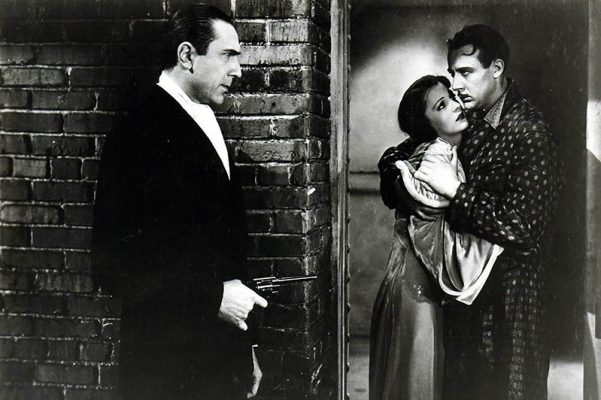Bela Lugosi became the victim of his own success after Dracula. As with so many actors who gave one indelible performance he found himself typecast in horror films for the rest of his career. Part of this is down to his ripe accent – his inability to neutralise his natural speech limited his options – but (like contemporaries James Cagney and Edward G. Robinson) he had a face that suited a particular kind of villainy. His suave, urbane malevolence is showcased in the three loose Poe adaptations that make up this box set, to varying degrees of success.
Murders in the Rue Morgue is the closest to the source material of the three, in terms of the story. It’s also the weakest. The film was made in part to placate Lugosi and director Robert Florey after James Whale chose to direct Frankenstein; originally slated for Florey with Lugosi starring. The star plays the invented role of Dr. Mirakle, who decides to prove the link between ape and man by mating his prize specimen Erik with pretty Camille (Sidney Fox), the fiancée of Leon Ames‘ amateur detective Pierre Dupin (changed for no apparent reason from C. Auguste Dupin in Poe’s original short story). As with the source material Dupin uses his deductive reasoning to solve the murders of Dr. Mirakle’s other victims through the conflicting accounts of three witnesses of differing nationalities. Barring some customarily gorgeous cinematography from the great Karl Freund (Der Golem, Dracula) and some impressive ape effects – several scenes preempt the following year’s King Kong – it’s a fairly lacklustre effort. Ames in later life called it: “A perfectly awful film that still pops up on TV to haunt me.” It’s nowhere near that bad, but Lugosi plays second fiddle to Ames in a standard villainous role that is nothing more than a lean-to clumsily bolted on to the main structure of the text. There is an interesting proto-Darwinist subtext rumbling beneath it all however.
Much more successful is The Black Cat. Directed by B-movie magician Edgar G. Ulmer and with the considerable added benefit a certain of Boris Karloff, it’s the finest of the trio. A rollicking psychological horror of revenge and satanism, it appeared just before the Hays Code began to be rigorously enforced, leaving all the chewy hints of incest and necrophilia intact. It’s Lugosi’s best performance of the three, ostensibly playing a heroic role, albeit one that takes a long time to reveal itself and is still rooted in his sinister urbanity. Essentially a battle of wills between Lugosi’s Vitus Werdegast, just released from 15 years in a PoW camp in Siberia, and Karloff’s ostentatiously widow’s-peaked satanist Hjalmar Poelzig, it’s two icons revelling in an enmity that may, or may not depending on who you believe, have spilled over into real life. Along for the ride are honeymooning couple Peter and Joan (David Manners and Julie Bishop), but both are completely pushed to the background by the central antagonism. There are some great scenes and neat touches, such as Karloff being both introduced, and memorably dispatched, in silhouette. It’s easy to see why director Ulmer has been critically reappraised recently as someone who could spin gold from the cheapest thread. The Black Cat bears practically no resemblance to the original story, but comes with the explanation: “Suggested by the Edgar Allan Poe classic”, which is rather charming.
A similar embellishment adorns the titles of The Raven. Again, there is little of Poe’s narrative poem in the film. But what it does have is a self-reflexive streak that could be called postmodern now. Lugosi’s central villain (a mad surgeon; always a winner), Dr. Vollin, is obsessed with Poe. After he saves the life of the beautiful Jean (Irene Ware), Vollin goes mad after her father insists he can’t pursue her romantically. Of course, this involves rigging up his house like the ‘murder castle’ of H.H Holmes, crammed with some of the devices of Poe’s imagination, like a pit complete with pendulum. He’s also roped in Boris Karloff’s escaped prisoner to do his bidding, disfiguring him through surgery and promising to change fix his looks in return for complaisance. The dynamic between the two greats is different here. Karloff is playing a variant on the monster with a soul for which he’s so beloved, while Lugosi is such a picture of placid cruelty he could have wandered in from the Nuremberg trials. Karloff just about shades it overall, although a wonky eye which is clearly just painted on to his eyelid is comically distracting, a rare misfire from the great makeup artist Jack Pierce. As with the other films in this box set, the Ware is naught but window dressing and damsels to be threatened or rescued. With the Hays Code by now in effect, it’s less gnarly than The Black Cat and director Lew Landers doesn’t put his stamp on the material in the same way that Ulmer does, but it’s still a brisk and enjoyable watch.
Overall, it’s a worthwhile box set for aficionados of both Lugosi and Poe. Amid the extras are a radio play of The Black Cat read by Peter Lorre, and two versions of The Tell-Tale Heart, one read by Boris Karloff, and one read by Bela Lugosi himself.
Available on Blu-ray from Mon 20 Jul 2020
